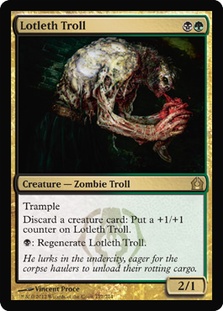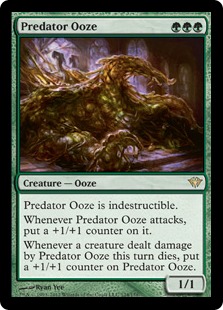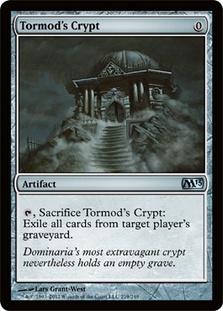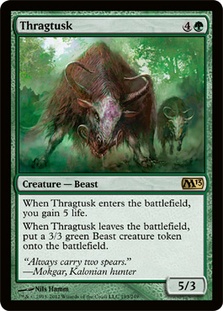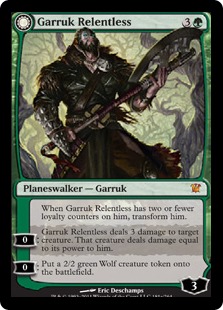Not long ago, someone asked me what my favorite card in Standard is. It was something that I hadn’t really thought about before. I know that Knight of the Reliquary is my favorite card in all of Magic, and I’ve been a big fan of other cards from time to time, like Huntmaster of the Fells, Vengevine, and Phyrexian Crusader, but I hadn’t stopped and taken the time to think about what my favorite card is right now.
This was back at Grand Prix Atlantic City, so it was before Gatecrash was released. I was playing G/B Ooze at that event, so it’s unsurprising that the card that that jumped to my mind was one in my deck: Ulvenwald Tracker.
Ulvenwald Tracker, much like Daybreak Ranger before it, is exactly the kind of card that I enjoy playing in Magic. I like to be aggressive and put pressure on my opponent, but I also want to have some sense of control over the game. There’s a reason you’ll find me playing with cards like Knight of the Reliquary but rarely with Goblin Guide. I prefer to play a deck that is able to switch gears between aggression and control based on the matchup rather than one that is always locked into one role or the other—basically, midrange decks. Some people deride midrange strategies, but I’ve made a career of playing three and four casting cost creatures, and I don’t plan on stopping any time soon.
What does this have to do with Ulvenwald Tracker? Well, Ulvenwald Tracker is a midrange deck’s dream. The idea of a midrange deck, generally speaking, is to be slightly slower and more powerful than the aggressive decks in order to be able to combat them in the early turns and trump them in the midgame. Ulvenwald Tracker takes the small edges that come with playing slightly more expensive and more resilient creatures and turns them into game dominance, as long as you can stay alive long enough to get him online. If you get Tracker going with any of your regenerators, your opponent is in a tough spot. If you get him going with Predator Ooze, they’re absolutely doomed.
Have you ever had two copies of The Abyss in play? Well, you can’t because it’s an enchant world. But you can have a Predator Ooze that your opponent is forced to chump block every turn to stay alive alongside Ulvenwald Tracker—that’s about as close as you’re going to get. Some people like to control games by eking out little advantages here and there with cards like Think Twice. I like to get my card advantage on the board by throwing my opponent’s creatures into the pit with mine since my creatures always come out on top.
All of these reasons contribute to why Ulvenwald Tracker is one of my favorite cards and also to why I chose to play G/B Ooze at SCG Standard Open: Las Vegas. As I wrote last week, I expected the Open to reflect the recent shift in Standard toward more aggressive decks like Naya Blitz and Jund Aggro, and I felt like that’s just the kind of field Ooze can prey upon. Get it? Predator Ooze? Prey Upon? Maybe I should leave the puns to Luis Scott-Vargas.
Anyway, here’s what I played:
Creatures (26)
- 4 Arbor Elf
- 4 Strangleroot Geist
- 4 Predator Ooze
- 3 Wolfir Avenger
- 3 Ulvenwald Tracker
- 4 Dreg Mangler
- 4 Lotleth Troll
Planeswalkers (2)
Lands (22)
Spells (10)

You can watch my deck tech here.
The only difference between the list I played and the one I posted in my article last week was the addition of the fourth Ulvenwald Tracker to the sideboard in place of the fourth Tragic Slip. I don’t think I need to sing Tracker’s praises any further, but the reasoning for the change was that I felt I needed ways to actually close out games against the other aggro decks in the field. It’s relatively easy to stabilize against an aggro deck’s assault with Strangleroot Geists, Oozes, Trolls, and the like, but it’s harder to actually go about winning the game from that point while keeping yourself alive. Tracker does exactly that while also serving as a tool to help you get there.
I started off 4-0 in the Open, beating an array of different aggro and midrange decks with relative ease. I actually set a personal record with a 12/12 Ooze in play at one point! I then lost to William “Baby Huey” Jensen playing Jund in an on-camera feature match. The difficulty of the Jund matchup can vary wildly based on their removal selection. Some Jund decks literally can’t kill a Predator Ooze, and some only have Liliana, which can be tough for them to use effectively.
Huey’s list—the one recommended by Reid Duke in his recent article here on SCG plays three copies of Tragic Slip, which is not only excellent against Predator Ooze but provides them with much needed cheap interaction and ways to deal with your regenerators. I lost to Huey 2-0, but both games were pretty competitive despite a turn 3 Olivia in the first. I was actually quite far ahead in the second, but Huey miracled a Bonfire to wipe my board when he pretty much needed exactly that to stay in the game.
I won my next two rounds and then played a super close match against B/W Zombies in round 7 for the ability to draw into Top 8. In the first game, I lost an incredibly close race, with the life loss from his second Geralf’s Messenger hitting me for exactly lethal when I had him at two life with a pair of Rancored Lotleth Trolls.
In game 2, I was able to get out to a solid lead and had a Garruk waiting in the wings after he Mutilated away the board that was able to take the match. In the final game, I was able to get some early advantages with an Ulvenwald Tracker, but my opponent had an Oblivion Ring to take out my Predator Ooze and his pair of Geralf’s Messengers took huge chunks out of my life total. I went all in on a Lotleth Troll plus Tracker to keep his Zombies at bay, but he had Lingering Souls to deal the final points in the air after I’d stabilized the ground.
All told, I was happy with how the deck played out. One problem that the deck has, though, is that it has relatively few powerful cards it can draw in long games or situations in which it’s behind. Predator Ooze is great when you play it early, but it needs time to ramp up and is much less impressive when you draw it on turn 9. My early versions of the deck had cards like Deadbridge Goliath and Garruk, Primal Hunter in an attempt to combat this, but I frequently found them stuck in my hand without the mana to cast them. The rest of the deck has such a low curve that I decided it was more important to try to avoid flooding and play a low land count, so I ultimately jettisoned the heavy hitters and went down to 22 lands to go along with my four Arbor Elf.
The biggest problem, I think, is that the Ooze deck doesn’t get to play any utility lands, so it can’t really afford to play a higher land count without flooding. How amazing would Kessig Wolf Run be in this deck?
I’ve entertained the idea of playing a G/R Predator Ooze deck because Domri Rade has overtaken Ulvenwald Tracker as my favorite card in Standard since Gatecrash became legal. At that point, though, your deck becomes extremely vulnerable to Boros Reckoner because you lose Abrupt Decay, and there’s really no good replacement for Lotleth Troll in Gruul. Flinthoof Boar isn’t that exciting to play alongside Predator Ooze because he doesn’t get many Mountains as support, and Burning-Tree Emissary plays much better in a deck that’s trying to put on as much pressure as possible in the early game.
That being said, I still think Ooze is a fine choice in the current environment, particularly if aggressive decks continue to make up much of the field. While I was very happy with the maindeck and wouldn’t change anything, I could definitely see shifting some things around in the sideboard. Deathrite Shaman has lost a lot of his allure to me with the shift toward more Boros Reckoner in U/W/R decks. Previously against U/W/R, I wanted to sideboard out all of my removal spells, but now I want to keep Abrupt Decay in to handle Reckoner (and the occasional Detention Sphere) so I have less room to bring things in.
Both Zombies and burn-heavy Mono-Red decks have fallen by the wayside a bit as well, which were two of the other matchups where I liked Deathrite Shaman. Now it’s pretty much just Reanimator where he’s any good, and frankly, I don’t think Shaman is enough to put you over the edge there. I’d rather play one or two really high impact cards against Reanimator like Tormod’s Crypt and use the Deathrite Shaman slots for something else.
I could see trying a pair of Thragtusks in the sideboard over the Deathrite Shaman. Previously, I’d been bringing both copies of Sever the Bloodline in against pretty much every opposing aggressive deck since while they’re not the best, they’re better than Rancor. Sever is great against midrange decks and incredibly important for dealing with stuff like Olivia, but it’s not what you want against something like Naya Blitz or Jund Aggro. While I feel those matchups are solid already, I think it’s worth trying out some more high-impact cards against them to avoid losing the close games where they narrowly burn you out. Thragtusk is also a fine card against removal-heavy decks like Esper or Jund where games go long and turn into battles of attrition.
This is what I’d try if I were battling this weekend:
Creatures (26)
- 4 Arbor Elf
- 4 Strangleroot Geist
- 4 Predator Ooze
- 3 Wolfir Avenger
- 3 Ulvenwald Tracker
- 4 Dreg Mangler
- 4 Lotleth Troll
Planeswalkers (2)
Lands (22)
Spells (10)

The second Appetite for Brains gets the boot for a second Crypt to help against Reanimator, while the two Thragtusks, as mentioned, take the place of the removed Deathrite Shamans. I haven’t tested this configuration yet, but it’s the direction I’d like to try next.
Some general tips and tricks:
– Against aggressive decks, sometimes it’s better to attack with your Ooze to get a counter on him rather than keep him back to block. It’s a lot harder for most decks to attack into a 2/2 Ooze than a 1/1, and it’ll get you that much closer to being able to fight their larger creatures with Tracker.
– Despite what Reuben Bresler may say, you definitely want to feed the Trolls. Don’t be afraid to grow a big Troll against decks that have difficulty dealing with it. While you won’t want to go all in on a Lotleth Troll against a deck with Unsummon and Azorius Charm, there are very few ways for many decks to deal with a Troll when it gets big enough. Keep in mind that any creature you draw can become Troll food, so you’ll want to think twice about playing them on a board where they might not be relevant.
– Keep in mind that you can always attack with Ooze and then use Tracker to fight things before damage to give Ooze an extra counter. Ooze also gets a counter whenever something it’s dealt damage to dies that turn, not only when it actually kills something with damage, so you can use Abrupt Decay or Tragic Slip to grow your Ooze sometimes. It can be better to attack into an opposing creature and let them block to grow your Ooze rather than kill it first and get damage in.
– Garruk has a lot of uses in this deck. You’ll very frequently want to use the -1 ability on his flip side to get Tracker, which can kill anything by fighting with a deathtouch Wolf. Also, his flipped ultimate comes up a lot more than you’d think. Keep in mind that deathtouch creatures with trample only have to assign one point of damage to anything blocking them and can do the rest to the opposing player, and remember that you can always discard a creature to Lotleth Troll before using the ultimate to increase the Overrun effect for your team. The math gets messy, but your opponent is dead more often than not if you can activate Garruk’s -3 ability.
I don’t know if I’d claim that this deck is the best in Standard, but I can say without hesitation that it’s the one I have the most fun playing. There’s something incredibly satisfying about watching your opponents realize that they too are going to become food for the Ooze. Like anything else, it’s just a matter of time.
Until next time,
bmk

